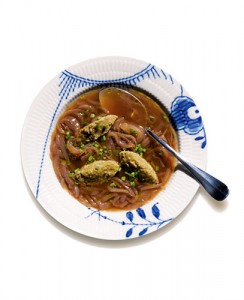
When the folks at Upper Playground asked me if I wanted to do a follow up interview to the”hoof arted video series” I said where. So here it is me sitting at Four barrel coffee getting bombarded with questions from Evan. The questions were good, the coffee was better, my answers were well you decide. So now it is out there in “The Citrus Report”. This Upper Playground newsletter, has nothing to do with a crop report like in the movie Trading Places. (see below)
Click here to view the embedded video. ]]>To read the article continue after the break.
Whole-Hearted
Chris Cosentino turns his nose-to-tail wisdom to seafood
San Francisco chef Chris Cosentino is known for using every last vestige of the animals he cooks at his Italian restaurant, Incanto, where head-to-tail specialties such as pig’s trotters, beef heart and lamb brains fill the menu. But anyone who’s sampled Cosentino’s famous Chilies and Bones dish (made from meaty ahi-tuna spine) knows his offal mastery also extends to seafood.
The Rhode Island native grew up clamming and eating local catches; he believes the whole-animal approach is the best way to treat a threatened food source like fish. Plus, he says, we’re missing out on some of the best parts (linguini with grated tuna heart and cod-sperm crostini have appeared on his menu).
But when it comes to cooking a whole fish at home, Cosentino eschews organs and innards in favor of no-nonsense recipes like this roasted striped bass with salmoriglio, a tangy herb-based Sicilian condiment. Making a whole fish isn’t only an easy way to feed a crowd, Cosentino says, it’s also easy on the cook. In other words: less guts, more glory.
Roasted Whole Striped Bass with Salmoriglio
Adapted from Chris Cosentino, Incanto
Makes 6 servings
Salmoriglio
¼ cup thyme leaves, coarsely chopped (stems reserved)
¼ cup oregano leaves, coarsely chopped (stems reserved)
1 cup parsley leaves, coarsely chopped (stems reserved)
2 garlic cloves, passed through a garlic press or mashed with a mortar and pestle
1 cup extra-virgin olive oil
Zest of one lemon
½ cup fresh lemon juice
Salt and pepper
Fish
One 5-pound striped bass, cleaned
4 each reserved stems of thyme, oregano and parsley
8 bay leaves
4 cloves garlic, crushed
1 lemon, thinly slices
1 medium red onion, sliced in ¼-inch rings
Salt and freshly ground pepper
Extra-virgin olive oil
1. In a bowl, mix the herbs with the garlic and olive oil. Add the lemon zest and juice and stir gently. Refrigerate until ready to serve.
2. Meanwhile, preheat the oven to 500°. Grease a baking sheet with olive oil.
3. Rinse the fish and pat dry. Trim off the fins.
4. Scatter the herb stems, bay leaves and garlic on the baking sheet. Place a row of lemon slices down the center of pan; reserve one slice. Place half of the onion slices over the lemon slices. Place the fish over the onions and season liberally with salt and pepper. Place the remaining onions on top of fish. Drizzle with olive oil and place the remaining slice of lemon on top of fish. Cover with foil and bake until the fish is cooked through, about 20 minutes. Serve the fish whole, with the salmoriglio sauce on the side.
THE OFFAL TRUTH
The Offal Truth
Once a staple of peasant cooking, variety meats are becoming the heart of high-end cuisine.
BY AMY ZAVATTO

COOKING IS AN ART FORM—and like some of history’s finest masterpieces, some of today’s most sought-after dishes incorporate seemingly unusable materials. What old newspapers and tires were to Robert Rauschenberg, jowls, en-trails and little piggy tails are to modern-day chefs.
But are these parts really what haute cuisine is made of? As a matter of fact, they are. Gone are the days when the word “sweetbread” incited a wrinkling of the nose, or eating a terrine made from a slow-simmered hog’s head was the feat of a culinary daredevil. Chefs across the country are boldly bringing the offal truth to fine-dining enthusiasts—and it appears they’re eating it up.
The word offal—or variety meats—actually comes from the simple but direct description “off-fall.” After an animal was butchered for all its choice skeletal-meat cuts, this was the stuff that was left over, or literally fell off.
“Right now, we’re going through anywhere from 50 to 75 pounds of pigs’ feet a week,” says Chef Chris Cosentino of San Francisco’s Incanto (www.incanto.biz; 415-641-4500), regarding his customers’ love of offal. “And nervetti [tendon] sells very well for us, too.”
For Cosentino and an army’s worth of other chefs around the country, using the entire animal is partly about respect and a desire to get away from wasteful decadence, and partly about the challenge, since it isn’t easy to turn innards into enticing dishes. One thing it’s not about: shock value. This might make for good episodes of “Fear Factor,” but even during the gross-out moments of “No Reservations,” Chef Anthony Bourdain has an admiration for food and the cultures that have long embraced the tenet of waste not, want not.
“Some of us refer to it as the Fifth Quarter,” says Chef Michael White of Convivio (www.convivionyc.com; 212-599-5045) and Alto (www.altorestaurant.com; 212-308-1099) in New York. White—whose practical Midwestern upbringing and seven-year cooking stint in Imola, Italy, greatly informs his nose-to-tail view of the culinary world—is fond of taking the food of the people to a higher level, serving slaved-over dishes like crostini of porchetta terrine made from slow-braised pig’s head, frito misto of calves brains (“They’re like cream puffs,” he says) and grilled, spiced lamb heart.
“It’s the kind of meat that the Romans were using after the wealthy people took away all the good stuff. They were left with the brains, the sweetbreads, the lungs, the spleen. It’s really the heart of Italian peasant cooking,” he says.
Actually, it’s the heart (and brains and kidney and thymus) of most peasant cooking. From fragrant, steaming bowls of Vietnamese pho, rich with beef tendon, to Southern American chitterlings (despite its cute-sounding name, it refers to pig intestine), the powerful farm-to-table movement has brought a variety of ethnic culinary traditions to the formerly squeamish, who are now clamoring for alternative cuts of cow, pig, lamb and even fish.
Ten or so years ago, you may have found the occasional sweetbreads and seared foie gras on a menu, but today, these items are as ubiquitous as steak, since demand and curiosity have grown like an overstuffed duck liver. Today, it’s dishes like Chef April Bloomfield’s cod milt (you don’t even want to know what this is) at New York’s The John Dory (www.thejohndory.com; 212-929-4948) that are winning critical raves.
“I think people have palate fatigue,” White says. “New Yorkers eat out every night. The people who are coming to my restaurant don’t cook at home; they’re foodies, devotees. Or they like to eat out a couple of days a week and cook at their own house the others. So they want to try things that they’re not apt to try on their own.”
But this trend isn’t limited to finicky New York gastronomes: Boston’s Eastern Standard (www.easternstandardboston.com; 617-532-9100) has a daily rotating offal menu, featuring dishes like lamb kidney stroganoff and seared veal liver over sunchoke purée with Vidalia onion rings, giving a whole new dimension to the blue plate special. Sweetbread and swiss chard risotto is served at Indianapolis’ L’Explorateur (www.dinelex.com; 317-726-6906), while Chef Jennifer Jasinski’s decadent seared rabbit loin with rabbit kidney mousse can be savored at Denver’s Rioja (www.riojadenver.com; 303-820-2282). And at the beloved little Zazu (www.zazurestaurant.com; 707-523-4814) in Santa Rosa, CA (55 miles from San Francisco), Chef John Stewart makes a pig heart sandwich with mustard-seed aioli that even managed to convert his formerly-vegetarian chef and wife Duskie Estes to an offal lover.
“You now have new flavors, new textures, new variation with the underlying flavor of that same animal,” Cosentino says. “It’s like a painter who just went from using five colors to 40.”
LAWFUL OFFAL
BEFORE YOU DIG IN, BE AWARE THAT SOME VARIETY MEATS ARE LEGALLY INEDIBLE.
While there is a veritable smorgasbord of offal from which to choose, some parts are deemed unfit for consumption by the Food Safety and Inspection Service, the public health wing of the USDA. The language can be tricky because, as FSIS public affairs representative Roger Sockman says, “Different cultures consume products that are not typically consumed by other cultures.”
Pigs’ feet, for example, are “generally” not edible, but because many cultures consider trotters to be downright delicious, you can find them for legal purchase in some stores or eateries. As a rule, however, Sockman notes that the following items generally are not considered edible: Hide or hair; hooves/feet; lungs; and spleen.
SPEAKING IN TONGUES
WHAT ARE LIGHTS? DON’T KNOW YOUR TROTTERS FROM YOUR GIBLETS?
HERE’S A HANDY GUIDE TO SOME VARIETY-MEAT MONIKERS YOU MAY BE LESS FAMILIAR WITH:
CAUL: The webby, fatty membrane around the stomach. Chefs generally take a cue from its original purpose and use it as a wrap or casing around other foods.
CHITTERLINGS: Also known as chitlins, these are the fatty small intestines of a pig and are very popular in deep Southern cooking.
GIBLETS: Remember mom’s Thanksgiving gravy? It got its great meat flavor from boiled, chopped up giblets—the heart, liver and, sometimes, gizzard of a bird.
HEAD CHEESE: Made from the slow, long braising of a pig’s head. After overnight cooking, the skin slides off and you are left with the various bits of meat and gelatinous residue. These are formed into a mold and usually served cold and sliced (and, no, there’s no actual cheese in it).
LIGHTS: For the haggis-loving public, this term means lung. In the US, though, the FDA outlawed serving lung to the public in 1972. However, some still try to slip it onto their menus.
SWEETBREADS: It is commonly thought that these tender nuggets are exclusively thymus glands in the neck, but the pancreas is another option.
TRIPE: Sponge-like in appearance, this is the stomach lining.
TROTTERS: As the name plainly suggests, feet.
]]>
Click on the picture for the recipe to the redux dish.
Each week the New York Times magazine does a column called Recipe redux by Amanda Hesser. This Sunday they featured a recipe, ironically from one of my regular guests parents which was published in 1971. The concept is simple Take a previously printed recipe and give it to a chef to use for inspiration or to take and turn it into something totally new. This was fun and a cool learning experience, they even let me use offal.
Here is a link to the article: Recipe Redux New York Times Magazine
]]>What a great event give 5 chefs each a different breed of pig and see what they come up with. This was so much fun to be given a breed of pig I had never worked with before the mangalista. A crazy wooly pig with a ton of fat, and lots of flavor. One of the highlights of the event for me was to spend some time with a true master of pork Mr. Allen Benton, who was not only super fun but a true believer of educating the next generation of the proper use of the magical animal the pig.
]]>
Click on the doctor to read the story.
Grist has an intresting article on the subject of shmeat. Do you really want to know what it is? I have voiced my concerns in the past and, as usual, PETA has been helping this product to be approved for human consumption. I am afraid that it will primarily be consumed by people who are of a lower socio-economical status.. What is that old saying, “shit rolls down hill” ? So, that must mean “shmeat rolls down hill” as well. It will end up in processed food, which goes to children in schools who depend on school lunch programs, and families who don’t have enough money. As well as most major fast food outlets that will grind this product into burgers as well as meat nuggets. This product will once again dumb down the palates and fatten the bodies of children. Take a look at the article, and speak up before star trek food is in the food system without you even knowing it.
]]>
For all of my Canadian Readers or anyone with dish you can check out my “At the table with”, I was blown away when they asked me to be a part of this. The caliber of the chefs they have worked with is amazing and I am honored to be among them. The Canadian food network team”Anthony and christoph” spent 8 days with me in SF and NYC filming and interviewing friends, colleagues, and family members. This is basically my life condensed into a 1/2 hour. They collected all my photos from my childhood until present I cant wait to see how this show turns out. I haven’t even seen it and its my life. Check your local listing and watch please let me know what you think.
]]>